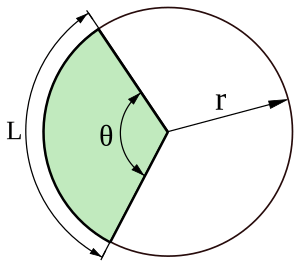Arc facts for kids
An arc is a part of a circle. Imagine drawing a circle; if you only draw a piece of its curved edge, that piece is an arc. It's like a curved line segment. Arcs always have a constant curve, meaning they don't get wobbly or change their bendiness.
Contents
What is a Circular Arc?
A circular arc is simply a section of the circumference of a circle. Think of it as a curved line that connects two points on the edge of a circle. These two points are called the endpoints of the arc.
Parts of a Circle and Arcs
To understand arcs better, it helps to know a few parts of a circle:
- Center: The middle point of the circle.
- Radius: A line segment from the center to any point on the circle's edge.
- Chord: A straight line segment connecting two points on the circle's edge. The arc is the curved path between these same two points.
How Arcs are Formed
An arc is formed by choosing two points on a circle. The curved path between these points is the arc. The size and shape of an arc depend on how far apart these two points are and the size of the circle itself.
Types of Arcs
Arcs can be different sizes, and we give them special names based on how much of the circle they cover.
Minor Arc
A minor arc is the shorter path between two points on a circle. It always measures less than half of the circle's circumference. If you pick two points, the minor arc is the "direct" curved route between them.
Major Arc
A major arc is the longer path between two points on a circle. It measures more than half of the circle's circumference. It's the "around the long way" route between the same two points that define a minor arc.
Semicircle
A semicircle is an arc that is exactly half of a circle. It is formed when the two endpoints of the arc are connected by a diameter of the circle. A diameter is a straight line that passes through the center of the circle and touches both sides.
Measuring Arcs
We can measure arcs in two main ways: by their length and by their angle.
Arc Length
The arc length is the actual distance along the curved line of the arc. It's like measuring how long a piece of string would need to be if you laid it perfectly along the arc. The length of an arc depends on the size of the circle (its radius) and how big the angle is that the arc makes at the center of the circle.
Arc Measure
The arc measure is the angle that the arc "cuts out" from the center of the circle. This angle is measured in degrees or radians. For example, a semicircle has an arc measure of 180 degrees because it's half of a 360-degree circle. The arc measure tells us how much of the circle's full turn the arc represents.
Arcs in Everyday Life
You might not realize it, but arcs are all around us!
Architecture and Design
Many buildings and structures use arcs for strength and beauty.
- Bridges: Many bridges have arched supports that help distribute weight evenly.
- Doorways and Windows: Some old and new buildings feature arched doorways or windows.
- Logos: Many company logos use curved lines and arcs in their design.
Nature
Arcs also appear naturally in the world.
- Rainbows: A rainbow is a beautiful example of a natural arc in the sky.
- Horizon: The curve of the Earth's horizon when you look out at a vast distance forms an arc.
Sports and Games
- Sports Fields: The three-point line in basketball or the penalty arc in soccer are examples of arcs drawn on playing fields.
- Swings: When you swing on a swing set, the path you take is an arc.
Understanding arcs helps us appreciate the geometry that shapes our world, from the smallest designs to the largest structures.
See also
 In Spanish: Arc para niños
In Spanish: Arc para niños


